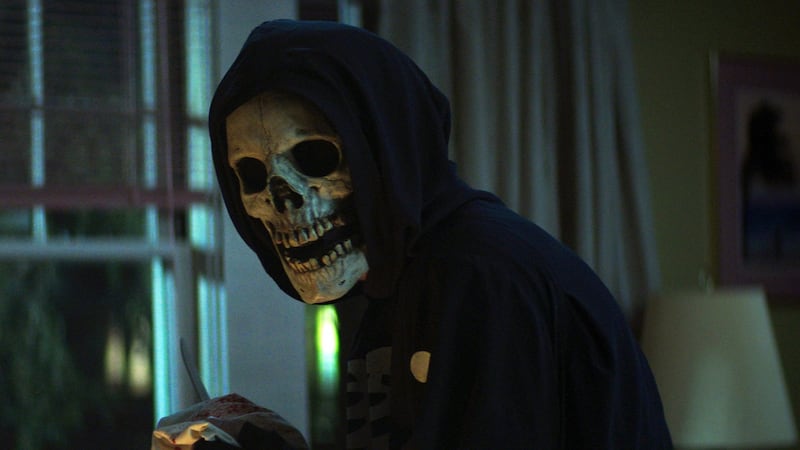It is tempting, when first wrapping one’s head around Netflix’s sprawling horror trilogy, to pull out the “who exactly is this thing for?” complaint. Based on a teen series by RL Stine, mega-selling author of Goosebumps, the films, released in successive weeks, are certainly inclining towards a younger audience, but there is a good deal more drug-taking, pneumatic sex and impromptu disembowelling than you would expect from, say, a Harry Potter adventure.
The Stranger Things fanbase is surely in the crosshairs. Like that Netflix original, Fear Street is deeply soaked in post-1960s pop culture. It is significant that the opening chapter is set in the mid-1990s and the second a little less than 20 years earlier. Two years before the release of Scream (if that Wes Craven film exists in this universe), a maniac in a black robe and skeleton mask is carving up the citizens of Shadyside, Ohio.

Fear Street Part One: 1994 lets us know that Shadyside, the supposed murder capital of the US, sits beside the more prosperous, just as nominatively determined, Sunnyville. The Shady folk have come to believe that a witch’s curse has doomed their town to this condition of eternal misery and damnation. Over a hugely busy opening third, Deena and Samantha (Kiana Madeira and Olivia Scott Welch), sometime girlfriends, cope with the aftermath of a shopping mall slaying as enemies in Sunnyville promise mayhem.
Their research eventually unearths information about a massacre in nearby Camp Nightwing 18 years earlier. We shan’t spoil any more of the opening film – the sections do just about work as standalone films – but it hardly needs to be said that Fear Street Part Two: 1978, told in flashback, riffs around teen slaughters in the Friday 13th movies. Sadie Sink does good work as a potential “final girl” troubled as much by echoes of ancient evil as by contemporaneous butchery.
Allusions
The mass of conspicuous allusions above don’t entirely clarify “who exactly this thing is for”. Stranger Things was equally steeped in entertainments first conceived before potential viewers arrived on the planet, but the works of Steven Spielberg and Stephen King are surely more firmly rooted in contemporary youth discourse than slasher films of the 1980s and 1990s. Perhaps the film-makers are waving to postmodernist academics attracted by the idea of entertainments looking nostalgically back to an era of horror – the uncertain millennial years – that endlessly casts its own nostalgic eyes knowingly to a period at a similar remove. Do keep up.
Fear Street comes across as less self-conscious than the above summary suggests. This is just the brackish water in which our heroes splutter for survival. Drawn in the bold terms of Stine’s teen aesthetics, the characters develop lives of their own that require no subtextual fleshing out to maintain our attention. Fear Street is, for all the allusions, breathing its own air. It is hard to think of another recent offering that so enthusiastically bridges the gap between the YA aesthetic and that of grown-up(ish) horror. Plenty of teenagers are robust enough for this degree of violence. Plenty will savour the movies’ relaxed, matter-of-fact attitudes – here is where nostalgia gets a deserved two fingers – to same-sex relationships. You didn’t get enough of that in 1994.
Arriving this week, Fear Street Part Three: 1666 owes more to The Crucible than it does to any American shocker (the flavours of British folk horror are surely accidental). We are, for a spell, back at the origins of the mayhem and, as is so often the case, women are being demonised. Though the decision to have the puritan settlers speak in largely terrible Irish accents defies all reason, the closing section ties up some ends in a satisfactory whirl of implausibly well-scrubbed colonial paranoia. Old lags may still be left wondering “who the thing is for”, but better that sort of confusion than another franchise designed by focus groups and demographic research. An oddball epic.
All three films available on Netflix from July 16th











